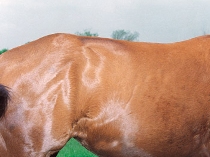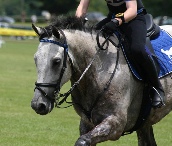 “Tying up” is a complicated condition that is not yet completely understood. It involves damage to the skeletal muscle (rhabdomyolysis) and the horse becomes stiff, painful, often sweating and reluctant to move. The heart rate and respiratory rates are often elevated and the horse often appears distressed. The gluteal muscles and loins are extremely painful to palpate. Red-brown urine is also commonly passed (myoglobinuria) and this is due to muscle breakdown products being excreted by the kidneys. These signs are usually seen within a couple of hours of exercise.
“Tying up” is a complicated condition that is not yet completely understood. It involves damage to the skeletal muscle (rhabdomyolysis) and the horse becomes stiff, painful, often sweating and reluctant to move. The heart rate and respiratory rates are often elevated and the horse often appears distressed. The gluteal muscles and loins are extremely painful to palpate. Red-brown urine is also commonly passed (myoglobinuria) and this is due to muscle breakdown products being excreted by the kidneys. These signs are usually seen within a couple of hours of exercise.
Causes of tying up
Any horse that is subjected to a sudden increase in training, exacerbated by electrolyte deficiencies, a high carbohydrate or imbalanced diet can tye-up acutely. The condition can vary in severity from mild stiffness and muscle pain to collapse, acute renal failure and death. However, most horses usually recover quickly following treatment and respond to improvements to their management and diet. The problem horses are the repeat offenders (recurrent exertional rhabdomyolysis) and recent research suggests that these horses are susceptible due to genetic factors.
Dr Valberg’s research attributes tying up in Thoroughbred racehorses to be due to abnormal control of muscle contraction. Muscle contraction involves release of calcium from intracellular storage organelles and relaxation is dependent on calcium being pumped back into these sites. Some horses are more susceptible to others to tying up. Even genetically susceptible horses may not show signs of disease, or may show only low grade signs such as poor performance, or failure to finish a race or event. Fillies are more susceptible to tying up than colts and geldings. Trigger factors for bringing on clinical disease include excitement, high grain diets, lameness, stress and exercise at submaximal speeds. Therefore, nervous, highly strung fillies on high grain diets are most commonly affected by disease.
Another cause of tying up is an abnormal ability to store sugar and polysaccharides in muscle (PSSM, or Polysaccharide Storage Myopathy). These horses accumulate glycogen (a storage form of sugar) and polysaccharide (an abnormal sugar) in the muscle cells. There are at least 2 forms of this disease: Type 1 is due to a mutation in the glycogen synthase gene. This condition has been described in Quarter Horses, draft breeds, Warmbloods, but not in the Thoroughbred so far. The mutation in the gene causes the horse to continually make glycogen rather than to use it for energy during exercise. These horses often also have an increased sensitivity to insulin which encourages further storage of glycogen in muscle cells.
 Type 2 PSSM is a genetic abnormality in polysaccharide storage in muscle but is not due to a mutation in the glycogen synthase gene. The genetic cause is not known. This disease has a different microscopic appearance of the muscle. Quarter Horses and Warmbloods are known to be affected. Thoroughbred horses may potentially also be affected. Type 1 PSSM can now be diagnosed by genetic testing of hair or blood at a specialized laboratory. Type 2 horses require a muscle biopsy to be sent to a specialized laboratory. Severely affected horses should also be tested for malignant hyperthermia, which is another genetic mutation which can be fatal.
Type 2 PSSM is a genetic abnormality in polysaccharide storage in muscle but is not due to a mutation in the glycogen synthase gene. The genetic cause is not known. This disease has a different microscopic appearance of the muscle. Quarter Horses and Warmbloods are known to be affected. Thoroughbred horses may potentially also be affected. Type 1 PSSM can now be diagnosed by genetic testing of hair or blood at a specialized laboratory. Type 2 horses require a muscle biopsy to be sent to a specialized laboratory. Severely affected horses should also be tested for malignant hyperthermia, which is another genetic mutation which can be fatal.
There are other rarer causes of tying up including immune-mediated myositis which has been attributed to influenza and streptococcal infections. These problems are extremely rare and therefore will not be discussed here in any detail.
Diagnosis
The clinical signs mentioned above are strongly suggestive that a horse has tied up. However, a blood test can be used to detect subclinical cases and also to determine the severity of the disease. Levels of CK (creatine kinase) and AST (aspartate aminotransferase) in the serum are measured. These products are markers of muscle damage. CK is released into the blood within several hours of muscle injury and returns to normal within 48 hours. Therefore, if CK levels are triple normal approximately 4-6 hours after exercise the horse most likely has the subclinical form of tying up. AST increases slower than CK and can take a week or more to return to normal. Therefore, looking at these enzymes gives information about the severity and time frame of the muscle damage. Urine testing can also demonstrate the presence of muscle breakdown pigment (myoglobin), however, this is usually not necessary. Diagnosis of PSSM, as outlined above, requires DNA sampling and/or muscle biopsies to be sent to specialized laboratories.
Treatment
 The intensity of treatment required will obviously depend on the severity of the tying up episode. The horse should be kept as calm as possible and moved to a clean, dry stable with comfortable bedding. If it is cold the horse should be rugged and kept comfortable. The horse should not be walked as this will only result in further muscle damage and discomfort. Fresh water and electrolytes should be provided. More serious cases will require intravenous fluid therapy. This is to not only address dehydration and electrolyte losses from sweating, but also to flush the kidneys. If myoglobin, the muscle breakdown product, is deposited in the kidneys this can result in kidney failure, which is fatal. Anti-inflammatories are required to relieve pain and anxiolytics such as acepromazine may also be advised by your veterinarian. The horse should only be fed hay until the horse is walking comfortably again, usually 24-48 hours.
The intensity of treatment required will obviously depend on the severity of the tying up episode. The horse should be kept as calm as possible and moved to a clean, dry stable with comfortable bedding. If it is cold the horse should be rugged and kept comfortable. The horse should not be walked as this will only result in further muscle damage and discomfort. Fresh water and electrolytes should be provided. More serious cases will require intravenous fluid therapy. This is to not only address dehydration and electrolyte losses from sweating, but also to flush the kidneys. If myoglobin, the muscle breakdown product, is deposited in the kidneys this can result in kidney failure, which is fatal. Anti-inflammatories are required to relieve pain and anxiolytics such as acepromazine may also be advised by your veterinarian. The horse should only be fed hay until the horse is walking comfortably again, usually 24-48 hours.
Prevention
Susceptible horses will always be prone to tying up. Preventing future episodes of tying up so that the horse can perform their intended job requires a strict routine that eliminates or minimizes the trigger factors for these horses. Stress and excitement should be kept to a minimum. There are many possible ways to help horses stay as relaxed as possible. For example, allowing a horse access to turnout during the day rather than continued stall confinement or a short extra time on the walker or a pick in hand can also help. Some horses will benefit from a pony as a mate next door to keep them relaxed in their stable. Some horses require medications to help keep them calmer and minimize the risk of repeated episodes of tying up. This should be discussed with your veterinarian. Obviously, the required withholding times must be adhered to.
Managing the diet is a further essential component of successfully keeping a horse susceptible to tying up in work. The diet must be balanced so that all essential vitamins and mineral requirements are met. Magnesium, Vitamin E and Selenium supplements can be helpful for these horses. Magnesium can also help calm nervy horses. The principle behind feeding these horses is to reduce the energy from carbohydrates as much as possible and provide fat as the alternative energy source. Oats have fewer carbohydrates (starch) than corn and barley, so at a quick glance may appear to be a safer feed for tying up horses. However, oats are highly absorbed in the small intestine and provide high levels of readily available carbohydrates. Extruded feeds have the same consequences as oats. Corn and barley have higher total starch contents, but are less digestible in the small intestine and are therefore safer grains to feed to minimize tying up episodes. However, feeds highly digested in the large intestine can increase the risk of laminitis or hind gut abnormalities so care should be taken to introduce these feeds gradually and not to feed excessive amounts.
Feeds rich in fat, or oils, especially omega 3 and omega 6 oils, are ideal for these horses. Some horses do not like fats in their food and horses that are nervy are often not good eaters anyway so it can be difficult to get the horses to eat their required diet. These horses can be frustrating but trying different feeds and adhering to the above principles should help in most cases. Ensure that concurrent stress-related problems such as gastric ulcers are not contributing to the horse’s finicky eating habits. Dr John Kohnke’s website provides an excellent description of diets and useful supplements for racehorses and performance horses with tying up: www.kohnkesown.com.
Consistency of exercise is essential in susceptible horses. It is important that their work is regular, consistent and there is adequate warming up and cooling down.
Medications and supplements available to help affected horses fall into several general types. Firstly, there are those aimed at settling horses down, as discussed above, stress and excitement are important trigger factors for tying up. These medications include acepromazine, herbal tranquilizers, magnesium, phenytoin and rakelin. Progestagens can also be useful for settling nervy fillies down and will sometimes help them eat better. Other medications are aimed at altering calcium transport, including dantrolene. Other supplements, for example kynoselen and tripart are intended to provide energy substrates such as ATP and amino acids, vitamins and minerals, especially Selenium and Vitamin E. It is important to be aware of the withholding periods of these drugs for racing and competitions.

Image 1 Source - Image 3 Source









